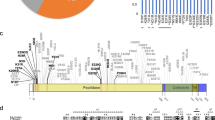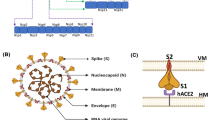Abstract
The objective of this study was to assess the impact of variations in the surface glycoprotein of SARS-CoV-2, which is generated by the spike (S) gene, on its interaction with host receptors in seventy-six viral Iraqi samples. Out of seven SNPs in the coding regions, three missense SNPs were identified. Based on phylogenetic analysis, four distinct groups of amino acid variations were revealed. In group-1 (p.N655H), group-2 (p.H622D), and group-3 (p.L449R), one missense SNP was observed, while no missense SNP was identified in the group-4 (wild-type) samples. Due to their novel amino acid variations, both group-1 and group-2 variants occupied two distinct phylogenetic positions in the tree. Molecular docking was performed between the identified S gene variants and the host angiotensin-converting enzyme 2 (ACE2) receptor, and the effects of these variants were evaluated. Compared with the other viral variations, docking revealed that p.N655H variant exhibited the highest affinity to the ACE2 receptor. It was found that patients infected with p.N655H variants showed a higher level of severity compared to the other types of infections. In conclusion, the observed p.N655H was associated with a higher severity of SARS-CoV-2 infection, which may be associated with greater host entry capacity compared to the wild type or other identified variants. These findings provide insights into the mechanism by which these novel viral strains interact with host cell receptors. They also highlight the importance of understanding virus-host interactions for assessing the impact of the global pandemic caused by SARS-CoV-2.




Similar content being viewed by others
Data Availability
Data sharing of this article is available upon request to the corresponding author.
Abbreviations
- ACE2:
-
Angiotensin-converting enzyme 2
- PDB:
-
Protein Data Bank
- CTD2:
-
C-terminal domain 2
- E:
-
Envelope
- GISAID:
-
Global Initiative on Sharing All Influenza Data
- HADDOCK:
-
High Ambiguity Driven biomolecular DOCKing
- iTOL:
-
Interactive Tree of Life
- M:
-
Membrane
- N:
-
Nucleocapsid
- S:
-
Spike gene
- SNP:
-
Single nucleotide polymorphism
- WHO:
-
World Health Organization
References
Al-Shuhaib MBS, Hashim HO (2023) Mastering DNA chromatogram analysis in Sanger sequencing for reliable clinical analysis. J Genet Eng Biotechnol 21:115. https://doi.org/10.1093/nar/gkh435
Al-Shuhaib MBS, Hashim HO, Al-Shuhaib JMB (2021) Epicatechin is a promising novel inhibitor of SARS-CoV-2 entry by disrupting interactions between angiotensin-converting enzyme type 2 and the viral receptor binding domain: A computational/simulation study. Comput Biol Med 141:105155. https://doi.org/10.1016/j.compbiomed.2021.105155
Alwan H, Torabi M, Nourani H, Al-Shuhaib MBS (2023) The emergence of novel Iranian variants in sheeppox and goatpox viral envelope proteins with remarkably altered putative binding affinities with the host receptor. Virus Genes 59:437–448. https://doi.org/10.1007/s11262-023-01987-z
Benson DA, Cavanaugh M, Clark K, Karsch-Mizrachi I, Ostell J, Pruitt KD, Sayers EW (2018) GenBank. Nucleic Acids Res 46:D41–D47. https://doi.org/10.1093/nar/gks1195
Bian J, Li Z (2021) Angiotensin-converting enzyme 2 (ACE2): SARS-CoV-2 receptor and RAS modulator. Acta Pharm Sin B 11:1–12. https://doi.org/10.1016/j.apsb.2020.10.006
Brant AC, Tian W, Majerciak V, Yang W, Zheng Z-M (2021) SARS-CoV-2: from its discovery to genome structure, transcription, and replication. Cell Biosci 11:1–17. https://doi.org/10.1186/s13578-021-00643-z
Buratto D, Saxena A, Ji Q, Yang G, Pantano S, Zonta F (2021) Rapid assessment of binding affinity of SARS-COV-2 spike protein to the human angiotensin-converting enzyme 2 receptor and to neutralizing biomolecules based on computer simulations. Front Immunol 12:4758. https://doi.org/10.1186/s13578-021-00643-z
Davidson AM, Wysocki J, Batlle D (2020) Interaction of SARS-CoV-2 and other coronavirus with ACE (angiotensin-converting enzyme)-2 as their main receptor: therapeutic implications. Hypertension 76:1339–1349. https://doi.org/10.1161/HYPERTENSIONAHA.120.15256
Dhand R, Li J (2020) Coughs and sneezes: their role in transmission of respiratory viral infections, including SARS-CoV-2. Am J Respir Crit Care Med 202:651–659. https://doi.org/10.1164/rccm.202004-1263PP
Dubey A, Choudhary S, Kumar P, Tomar S (2022) Emerging SARS-CoV-2 variants: genetic variability and clinical implications. Curr Microbiol 79:20. https://doi.org/10.1007/s00284-021-02724-1
Elfiky AA, Ibrahim IM, Elgohary AM (2022) SARS-CoV-2 Delta variant is recognized through GRP78 host-cell surface receptor, in silico perspective. Int J Pept Res Ther 28:146. https://doi.org/10.1007/s10989-022-10450-w
Fan W, Mencius J, Du W, Fan H, Zhu H, Wei D, Zhou M, Quan S (2021) Online bioinformatics teaching practice: Comparison of popular docking programs using SARS-CoV-2 spike RBD–ACE2 complex as a benchmark. Biochem Mol Biol Educ 49:833–840. https://doi.org/10.1002/bmb.21566
Haque A, Pant AB (2022) Mitigating Covid-19 in the face of emerging virus variants, breakthrough infections and vaccine hesitancy. J Autoimmun 127:102792. https://doi.org/10.1016/j.jaut.2021
Harvey WT, Carabelli AM, Jackson B, Gupta RK, Thomson EC, Harrison EM, Ludden C, Reeve R, Rambaut A, 19 Genomics UK (COG-UK) Consortium (2021) SARS-CoV-2 variants, spike mutations and immune escape. Nat Rev Microbiol 19:409–424. https://doi.org/10.1038/s41579-021-00573-0
Holmberg V, Salmi H, Kattainen S, Ollgren J, Kantele A, Pynnönen J, Järvinen A, Forsblom E, Silén S, Kivivuori S-M (2022) Association between first language and SARS-CoV-2 infection rates, hospitalization, intensive care admissions and death in Finland: a population-based observational cohort study. Clin Microbiol Infect 28:107–113. https://doi.org/10.1016/j.cmi.2021.08.022
Huang Y, Yang C, Xu X, Xu W, Liu S (2020) Structural and functional properties of SARS-CoV-2 spike protein: potential antivirus drug development for COVID-19. Acta Pharmacol Sin 41:1141–1149. https://doi.org/10.1038/s41401-020-0485-4
Jackson CB, Farzan M, Chen B, Choe H (2021) Mechanisms of SARS-CoV-2 entry into cells. Nat Rev Mol Cell Biol 23:3–20. https://doi.org/10.1038/s41580-021-00418-x
Kalathiya U, Padariya M, Mayordomo M, Lisowska M, Nicholson J, Singh A, Baginski M, Fahraeus R, Carragher N, Ball K (2020) Highly conserved homotrimer cavity formed by the SARS-CoV-2 spike glycoprotein: a novel binding site. J Clin Med 9:1473. https://doi.org/10.3390/jcm9051473
Kelley LA, Mezulis S, Yates CM, Wass MN, Sternberg MJE (2015) The Phyre2 web portal for protein modeling, prediction and analysis. Nat Protoc 10:845–858. https://doi.org/10.1038/nprot.2015.053
Klein S, Cortese M, Winter SL, Wachsmuth-Melm M, Neufeldt CJ, Cerikan B, Stanifer ML, Boulant S, Bartenschlager R, Chlanda P (2020) SARS-CoV-2 structure and replication characterized by in situ cryo-electron tomography. Nat Commun 11:5885. https://doi.org/10.1038/s41467-020-19619-7
Komar AA (2007) SNPs, silent but not invisible. Science 315:466–467. https://doi.org/10.1126/science.1138239
Lan J, Ge J, Yu J, Shan S, Zhou H, Fan S, Zhang Q, Shi X, Wang Q, Zhang L (2020) Structure of the SARS-CoV-2 spike receptor-binding domain bound to the ACE2 receptor. Nature 581:215–220. https://doi.org/10.1038/s41586-020-2180-5
Lanjanian H, Moazzam-Jazi M, Hedayati M, Akbarzadeh M, Guity K, Sedaghati-Khayat B, Azizi F, Daneshpour MS (2021) SARS-CoV-2 infection susceptibility influenced by ACE2 genetic polymorphisms: insights from Tehran Cardio-Metabolic Genetic Study. Sci Rep 11:1529. https://doi.org/10.1038/s41598-020-80325-x
Laskowski RA (2001) PDBsum: summaries and analyses of PDB structures. Nucleic Acids Res 29:221–222. https://doi.org/10.1093/nar/29.1.221
Letunic I, Khedkar S, Bork P (2021) SMART: recent updates, new developments and status in 2020. Nucleic Acids Res 49:D458–D460. https://doi.org/10.1093/nar/gkaa937
Li J, Lai S, Gao GF, Shi W (2021) The emergence, genomic diversity and global spread of SARS-CoV-2. Nature 600:408–418. https://doi.org/10.1038/s41586-021-04188-6
MacGowan SA, Barton MI, Kutuzov M, Dushek O, van der Merwe PA, Barton GJ (2022) Missense variants in human ACE2 strongly affect binding to SARS-CoV-2 Spike providing a mechanism for ACE2 mediated genetic risk in Covid-19: A case study in affinity predictions of interface variants. PLoS Comput Biol 18:e1009922. https://doi.org/10.1371/journal.pcbi.1009922
Madeira F, Park YM, Lee J, Buso N, Gur T, Madhusoodanan N, Basutkar P, Tivey ARN, Potter SC, Finn RD (2019) The EMBL-EBI search and sequence analysis tools APIs in 2019. Nucleic Acids Res 47:W636–W641. https://doi.org/10.1093/nar/gkz268
Madeira F, Pearce M, Tivey ARN, Basutkar P, Lee J, Edbali O, Madhusoodanan N, Kolesnikov A, Lopez R (2022) Search and sequence analysis tools services from EMBL-EBI in 2022. Nucleic Acids Res 50:W276–W279. https://doi.org/10.1093/nar/gkac240
Maginnis MS (2018) Virus–receptor interactions: the key to cellular invasion. J Mol Biol 430:2590–2611. https://doi.org/10.1016/j.jmb.2018.06.024
Mahram A, Herbordt MC (2010) Fast and accurate NCBI BLASTP: Acceleration with multiphase FPGA-based prefiltering. In: Proceedings of the 24th ACM International Conference on Supercomputing pp 73–82. https://doi.org/10.1145/1810085.1810099
McGinnis S, Madden TL (2004) BLAST: at the core of a powerful and diverse set of sequence analysis tools. Nucleic Acids Res 32:W20–W25. https://doi.org/10.1093/nar/gkh435
Meyerowitz EA, Richterman A, Gandhi RT, Sax PE (2021) Transmission of SARS-CoV-2: a review of viral, host, and environmental factors. Ann Intern Med 174:69–79. https://doi.org/10.7326/M20-5008
Sands TR (2021) Keeping your lab together in the COVID-19 era. Genome Biol 22:234. https://doi.org/10.1186/s13059-021-02457-1
Shu Y, McCauley J (2017) GISAID: Global initiative on sharing all influenza data–from vision to reality. Eurosurveillance 22:30494. https://doi.org/10.2807/1560-7917.ES.2017.22.13.30494
Tahsin A, Ahmed R, Bhattacharjee P, Adiba M, Al Saba A, Yasmin T, Chakraborty S, Hasan AKMM, Nabi AHMN (2022) Most frequently harboured missense variants of hACE2 across different populations exhibit varying patterns of binding interaction with spike glycoproteins of emerging SARS-CoV-2 of different lineages. Comput Biol Med 148:105903. https://doi.org/10.1016/j.compbiomed.2022.105903
Takemura K, Kitao A (2019) More efficient screening of protein-protein complex model structures for reducing the number of candidates. Biophys Physicobiol 16:295–303. https://doi.org/10.2142/biophysico.16.0_295
Teslya A, Pham TM, Godijk NG, Kretzschmar ME, Bootsma MCJ, Rozhnova G (2020) Impact of self-imposed prevention measures and short-term government-imposed social distancing on mitigating and delaying a COVID-19 epidemic: A modelling study. PLoS Med 17:e1003166. https://doi.org/10.1371/journal.pmed.1003166
Thusberg J, Vihinen M (2009) Pathogenic or not? And if so, then how? Studying the effects of missense mutations using bioinformatics methods. Hum Mutat 30:703–714. https://doi.org/10.1002/humu.20938
Tian W, Li D, Zhang N, Bai G, Yuan K, Xiao H, Gao F, Chen Y, Wong CCL, Gao GF (2021) O-glycosylation pattern of the SARS-CoV-2 spike protein reveals an “O-Follow-N” rule. Cell Res 31:1123–1125. https://doi.org/10.1038/s41422-021-00545-2
Towler P, Staker B, Prasad SG, Menon S, Tang J, Parsons T, Ryan D, Fisher M, Williams D, Dales NA (2004) ACE2 X-ray structures reveal a large hinge-bending motion important for inhibitor binding and catalysis. J Biol Chem 279:17996–18007. https://doi.org/10.1074/jbc.M311191200
Walls AC, Park Y-J, Tortorici MA, Wall A, McGuire AT, Veesler D (2020) Structure, function, and antigenicity of the SARS-CoV-2 spike glycoprotein. Cell 181:281-292.e6. https://doi.org/10.1016/j.cell.2020.02.058
Yang Y, Du L (2021) SARS-CoV-2 spike protein: a key target for eliciting persistent neutralizing antibodies. Signal Transduct Target Ther 6:95. https://doi.org/10.1038/s41392-021-00523-5
Ye J, Coulouris G, Zaretskaya I, Cutcutache I, Rozen S, Madden TL (2012) Primer-BLAST: a tool to design target-specific primers for polymerase chain reaction. BMC Bioinform 13:134. https://doi.org/10.1186/1471-2105-13-134
Yi CE, Ba L, Zhang L, Ho DD, Chen Z (2005) Single amino acid substitutions in the severe acute respiratory syndrome coronavirus spike glycoprotein determine viral entry and immunogenicity of a major neutralizing domain. J Virol 79:11638–11646. https://doi.org/10.1128/JVI.79.18.11638-11646.2005
Van Zundert GCP, Rodrigues J, Trellet M, Schmitz C, Kastritis PL, Karaca E, Melquiond ASJ, van Dijk M, De Vries SJ, Bonvin A (2016) The HADDOCK2. 2 web server: user-friendly integrative modeling of biomolecular complexes. J Mol Biol 428:720–725. https://doi.org/10.1016/j.jmb.2015.09.014
Acknowledgements
The authors would like to thank the medical staff of the Hilla General Teaching Hospital (Babil Province), Karbala General Teaching Hospital and Karbala Teaching Hospital for Children (Karbala Province), Hakeem Teaching Hospital (Najaf Province), and Public Health Laboratory (Baghdad) for kindly providing us with the SARS-CoV-2 infected samples.
Author information
Authors and Affiliations
Contributions
MRRA and KNJM; collected samples, and performed genotyping experiments. ASA; participated in the laboratory work. MBSA; designed PCR primers, analyzed data, and wrote the manuscript. All authors approved the final draft of the manuscript.
Corresponding author
Ethics declarations
Ethical approval
WHO guidelines were followed.
Conflict of interest
The authors declare that they have no conflict of interest.
Additional information
Publisher's note
Springer Nature remains neutral with regard to jurisdictional claims in published maps and institutional affiliations.
Supplementary Information
Below is the link to the electronic supplementary material.
Rights and permissions
Springer Nature or its licensor (e.g. a society or other partner) holds exclusive rights to this article under a publishing agreement with the author(s) or other rightsholder(s); author self-archiving of the accepted manuscript version of this article is solely governed by the terms of such publishing agreement and applicable law.
About this article
Cite this article
Al-Mousawi, M.R.R., Musafer, K.N.J., Alattabi, A.S. et al. The emergence of a novel SARS-CoV-2 variant with higher efficiency of binding with the human host cell receptors in Iraqi subjects. Biologia 79, 629–641 (2024). https://doi.org/10.1007/s11756-023-01583-4
Received:
Accepted:
Published:
Issue Date:
DOI: https://doi.org/10.1007/s11756-023-01583-4




